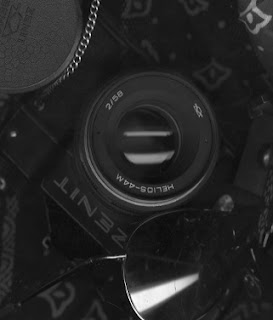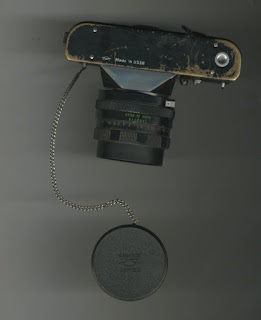I found this work's process particularly interesting; as it reminded me of the random "Zen" philosophy-inspired works of John Cage. Although Cage's medium was less visually-portrayed than musical, the idea of controlled chaos, the carefully pruned random, I found to be quite similar. It also very interestingly successfully and seamlessly ties together the worlds of computer programming and art in ways that I have never seen before; yet this piece was completed in the late 1960s.
Thursday, September 27, 2012
Georg Nees: Artist Profile
For my artist profile, I decided to research further the inspiration, methods, and works of the computer program artist Georg Nees. Initially, I found his work aesthetically pleasing without even knowing of its digital origins, and unbiased by the knowledge of its artistic process. In particular, I am referring to his work "Untitled (Gravel Stones)" which he created using a randomly-generating computer program and digitally-controlled "pen" to visually represent these random generations.
Thursday, September 20, 2012
Artist Proflie: Marcel Duchamp's "Fountain"
For my artist post, I wanted to pursue an artist that operated in the duration of the Dada movement, in particular the category of appropriation; due to its ties to image-appropriation in digital media creation. I wanted to explore this relationship, and thought perhaps it would assist me in inspiration for my first digital media project, which will involve an extensive amount of digital appropriation of photographs.
Duchamp was a member of the New York Dadaist movement in the late 1950s, operating within a larger, international movement, although European and American Dada movements differed slightly, especially in terms of subject matter and artistic goals. European Dada was a direct response to the horrors of WWI, and was thusly much graver, whereas the New York movement was less "serious."
Duchamp's artistic legacy is extensive and spans many artistic phases, but I wish to concentrate on his contribution and exploration in Dada, specifically his well-known and famous work, "Fountain," ca. 1917. In this work, Duchamp appropriates a latrine toilet, places it on a wall, and declares it art. However, this seemingly simple work actually helps illustrate the meaning of art: an idea and meaning applied to an object, rather than the object itself. Placed into a exhibitory context, this latrine becomes a piece of art, with an alternate meaning, and an alternate idea behind it. I wish to pursue a similar exploration, the expression of an idea through the morphed meaning of appropriated objects and images, through my first digital project.
Duchamp was a member of the New York Dadaist movement in the late 1950s, operating within a larger, international movement, although European and American Dada movements differed slightly, especially in terms of subject matter and artistic goals. European Dada was a direct response to the horrors of WWI, and was thusly much graver, whereas the New York movement was less "serious."
source: wikipedia.org
Duchamp's artistic legacy is extensive and spans many artistic phases, but I wish to concentrate on his contribution and exploration in Dada, specifically his well-known and famous work, "Fountain," ca. 1917. In this work, Duchamp appropriates a latrine toilet, places it on a wall, and declares it art. However, this seemingly simple work actually helps illustrate the meaning of art: an idea and meaning applied to an object, rather than the object itself. Placed into a exhibitory context, this latrine becomes a piece of art, with an alternate meaning, and an alternate idea behind it. I wish to pursue a similar exploration, the expression of an idea through the morphed meaning of appropriated objects and images, through my first digital project.
Thursday, September 13, 2012
Digital Technology Log
24-hour technology log:
0000 - 0100 - 1 hr computer, 4 txt msgs, 1 hr music
0100 - 0200 - 1 hr computer, 1 hr music
0200 - 0300 - 1 hr computer, 1 hr music
0300 - 0400 - 2 txt msgs, 30 min comp.
0400 - 0500 - sleep
0500 - 0600 - sleep
0600 - 0700 - sleep
0700 - 0800 - sleep
0800 - 0900 - sleep
0900 - 1000 - alarm clock, 1 txt msg
1000 - 1100 - 2 emails, 30 min computer use, 3 txt msgs
1100 - 1200 - 1 hr computer use, 2 emails
1200 - 1300 - 1 hr computer use, 1 hr music, 4 txt msgs
1300 - 1400 - 3 txt msgs, 1 hr music, 3 emails
1400 - 1500 - 1 hr computer use
1500 - 1600 - 1 hr computer use
1600 - 1700 - 1 hr music, 3 txt msgs
1700 - 1800 - 30 min music, 2 txt msgs
1800 - 1900 - sleep
1900 - 2000 - sleep
2000 - 2100 - 1 hr computer use, 4 emails, 3 txt msgs, 30 min music
2100 - 2200 - 1 hr computer use, 1 hr music, 2 txt msgs
2200 - 2300 - 1 hr computer use, 1 hr music, 4 txt msgs
2300 - 0000 - 1 hr computer use, 1 hr music, 2 txt msgs
The digital world never sleeps, and after seeing this visual representation of my average day schedule, apparently I rarely do too. Needless to say, I would probably be much less sleep-deprived if I lived in a log cabin.
Tuesday, September 11, 2012
Monday, September 10, 2012
Wednesday, September 5, 2012
Three-Dimensional Scans
For this series of scans, I wanted to experiment with a wide variety of objects; to push the boundaries of the scanner and use it as a photographer would frame an image, but also in the traditional sense of scanning a two-dimensional object, which I have disappointingly little experience with. As a result, these scans form a sort of displaced examination of the objects I happened to have in my bag at the time. They are all quite personal to me, and have some sort of meaning in one way or another, but the question would be, is this still portrayed through this bland, naked examination of these objects, against a stark white background? Will the viewer realize the personality in each item, or is that stripped by the complete lack of visually contextual background? This is a question I would like to think about in the upcoming collage project.
For this last image, I wanted to explore and push the boundaries of the scanner, and think of it as a giant camera, to create an inverted, three-dimensional image that uses negative space to draw the viewer's eye around the work. It is a collage of some sorts I suppose, although it consists of objects in my possession alone, and therefore would not be acceptable to submit as my collage project's final product. However, perhaps it is a new idea for me to continue exploring?
Tuesday, September 4, 2012
Pixel Art: Image #1 (non-animated)
For my first attempt at a pixel drawing, I was originally
completely stuck as to what direction I wanted to proceed in. I ended up favoring a type of image based
more upon the idea and a collision of artistic genres than a purely
illustrative work, and an expression of my personal interests immediately
became an inspiration. I have a deep
interest in musical composition, and while brainstorming a subject for my pixel
drawing, I noticed that the extremely small, pixelated resolution of the blank
photoshop document I was looking at on my monitor was not unlike a simple
digital, graphic-based step-sequencer used in basic music production.
I Googled step-sequencer images, and I quickly found a free,
online step-sequencer that I could use to patch together my pixel image, and
use as a "musical translator" of sorts; effectively transforming
musical expression into graphic expression.
The sequencer can be found at this link: http://tonematrix.audiotool.com/
and is very useful for experiencing the work in its full potential; i.e.
hearing, as well as seeing the work.
Thusly, for my pixel art, I have created a visual
representation of a musical phrase. It is a simple, interactive piece that I feel encourages viewer interaction--I am hoping the viewer will use his or her computer to travel to the sequencer website, and using
my work as a template, simply graphically transcribing my notes onto their own
browser; allowing them to hear as well as see the work. Perhaps this may even ignite an artistic
conversation of sorts, as they build their own musical melody, and transcribe
it in the same fashion, allowing others to share their creation graphically as
well as musically.
Subscribe to:
Comments (Atom)















